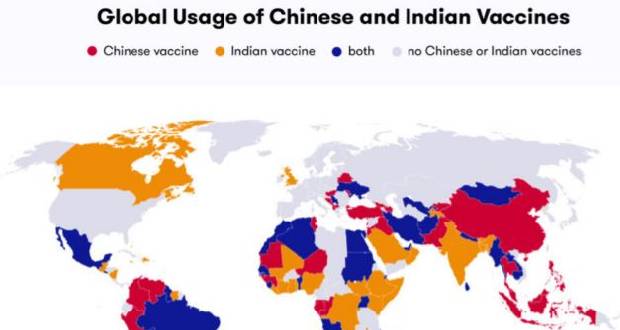Publicité
How India’s curb on vaccine exports opens the door for China in the Indian Ocean
Par
Partager cet article
How India’s curb on vaccine exports opens the door for China in the Indian Ocean

India seems to have hit a pothole in its vaccine diplomacy strategy to keep Beijing from making inroads. This was particularly evident in the Indian Ocean. Faced with growing Covid-19 cases at home, India has curbed its export of Covid-19 vaccines. So how does New Delhi calling a break in its vaccine diplomacy lead to opportunity for Beijing in the Indian Ocean?
Vaccine diplomacy
The scramble over Covid-19 vaccines globally has come as a golden opportunity for both India and China to engage in what has come to be billed as ‘vaccine diplomacy’. With richer countries hoarding vaccine stocks (mostly Pfizer/BioNtech or Moderna) from middle-income and poorer nations, most of them have turned to vaccines produced in India, China or Russia to inoculate their citizens, with New Delhi and Beijing seizing the opportunity to improve their image and influence amongst middle-income and poor countries across the globe. And use vaccines as another front in their own escalating geopolitical competition. (see map) Within the Indian Ocean the India-China dynamic and vaccine competition has been no different. “Vaccines are a part of the game,” Jean Claude de l’Estrac, former foreign minister and former secretary-general of the Indian Ocean Commission tells l’express. Even before Covid-19, the competition between New Delhi and Beijing for the Indian Ocean was intense, “it’s all about the geopolitical position of the islands of the Indian Ocean and the sea routes, it’s about China increasing its naval presence in the region and getting port facilities in countries like Pakistan and Djibouti, this is the context in which this is taking place,” de l’Estrac points out. Not surprisingly, in the vaccine game in the Indian Ocean, “the only two real players are India and China, maybe with an advantage for India, which is unmatched as a vaccine manufacturer, although China is catching up,” he adds. So when India announced its ‘Vaccine Maitri’ (vaccine friendship) policy, it was no surprise that India seemed poised to get the better of China in the vaccine race in Mauritius’ neighbourhood. China may have announced its ‘Health Silk Road’ in March 2020, but even before Covid-19, India was already producing 65 percent of the world’s vaccines and the Serum Institute of India could pump out up to 2.5 million doses of AstraZeneca daily.
The curbs by India
Things seemed to be going India’s way until in March, New Delhi announced curbs on vaccine exports to vaccinate more of its own citizens at home. Although under its vaccine diplomacy efforts, India has supplied vaccines to over 70 countries, within India itself the pace of vaccination has been slower. By March, only 50 million jabs were delivered to Indian citizens – less than 5 percent of India’s 1.3 billion people. Shifting the focus to diplomatic outreach was always a risky strategy, made more sustainable after India was hit by a second wave of Covid-19 in March, with the average number of cases soaring from 11,000 in mid-February to 50,000 by mid-March, more than half of them Maharashtra, which hosts India’s financial capital Mumbai (accounting for nearly 14 percent of the entire Indian economy) and which is currently under a fresh lockdown. “The temporary ban on exports by India comes as part of the debate within India that you cannot export more vaccines than you are keeping for yourself,” explains de l’Estrac. Former foreign secretary and deputy secretary general of the AU, Vijay Makhan tells l’express that the decision by India to curb vaccine exports “comes as a cold shower for developing countries banking on India, you cannot hold that against them though you have a huge population to vaccinate, the population of one town is probably bigger than all the countries of the Indian Ocean combined, so the pressure on them must be huge.”
How has India’s export halt affected Indian Ocean countries?
The decision from New Delhi has not affected all the countries in Mauritius’ neighbourhood in the same way. Mauritius, for example, has long been a battleground between India and China, both having financed infrastructure development within the country. India signed a trade pact with Mauritius in February this year, a month after a trade pact between Mauritius and China came into effect. India is developing a naval facility on Mauritius’ Agalega island, while the Chinese state-backed firm Huawei is helping Mauritius in its 'Safe City' project, one of the largest and most technically ambitious, infrastructural projects in the country’s history.

When it came to vaccines, however, India had a definite headstart. After an initial donation of 100,000 doses of the Indian-made AstraZeneca vaccine, Mauritius followed up with further orders of the vaccine. But the pinching off of vaccine exports by India has had an effect: Until now Mauritius’ vaccine supply has been dominated by India. In mid-December, Mauritius opened talks with the Russians to secure 1.2 million doses of Sputnik V. That is not such a problem, given that by January this year with 100 million doses on order, India was one of the biggest customers of the Russian vaccine. However, in March this year, the troubles of the Indians meant a door opening for China. According to health minister Kailesh Jagutpal speaking in parliament on March 23, 2021, after being approached by the Indian High Commission to buy Covaxin on March 5, Mauritius looked to get one million doses of Covaxin. “However, on March 18, 2021, my ministry was informed that due to export restrictions on vaccines, the government of India has authorised the sale of only 200,000 doses,” which reached Mauritius on March 19. Just days earlier, on March 12, according to Jagutpal, the Chinese government agreed to donate 100,000 doses of Sinopharm to Mauritius. On Tuesday, Jagutpal added that Mauritius was now looking to buy 500,000 doses of another Chinese vaccine, Sinovac. “The fact that your primary supplier is not able to supply the vaccines in the quantity you need means that you have to look elsewhere,” says Makhan. .
But Mauritius is not the only key battleground for influence via vaccines in the neighbourhood. In Seychelles, much the same story has played out. “We have to remember that in Seychelles there was an agreement between the previous government (led by Danny Faure -ed.) and India to build a base on Ascension Island, that was debated during the election and the new President (Wavel Ramkalawan -ed.) decided not to have a base. That’s a big blow to the Indians,” de l’Estrac points out. So when Covid-19 hit, Seychelles was one of the first states in the world to kickstart its vaccination programme in a big way in January, with 50,000 doses of Sinopharm donated by the United Arab Emirates. To counteract this, two weeks after the Chinese vaccines landed, an Indian navy ship also went there carrying 50,000 doses of AstraZeneca. “The vaccines allowed the Indians to make a comeback, this is what soft power is all about,” maintains de l’Estrac. With Seychelles already having reached herd immunity by vaccinating nearly 70 percent of its population, “the issue is now more or less closed. If you want to call it a race, then the advantage went to China; that was a decision that the Seychellois president took and they acted fast, unlike here where we have just been shooting our mouths off,” offers Makhan.
In other states of the region too, vaccines have followed in the footsteps of geopolitics. In Maldives, the elections in 2018 brought to power the government of Ibrahim Solih, considered closer to New Delhi than to Beijing. “The Chinese are very much present in Maldives and for many years were financing huge infrastructure projects,” explains de l’Estrac, “now under Ibrahim Solih they are getting much more money and infrastructure from the Indians.” So when it came time for vaccines, India jumped first and offered a donation of 100,000 doses of AstraZeneca with Maldives looking to buy 700,000 more doses. In March, China doubled its own offer for Sinopharm vaccines from 100,000 to 200,000 doses with Maldives buying another 218,000 doses of the Chinese vaccine. In Sri Lanka, a much more interesting story took place: in January India sent 500,000 doses of AstraZeneca with the Chinese countering by offering a donation of 300,000 doses of Sinopharm. However, in February, Sri Lanka suspended the use of Sinopharm vaccines and announced plans to rely on AstraZeneca. That same month, tensions between India and Sri Lanka rose over a key port deal that would have allowed India’s Adani Group to buy nearly half of Colombo’s East Container Terminal (to counter China’s Hambantota Port) went sour after Colombo pulled out of the deal. By mid-March, the Sri Lankan President ordered his health authorities to fasttrack approvals for Sinopharm. By the end of March, Sri Lanka received 600,000 doses of Sinopharm vaccines. “All of the countries within the Indian Ocean are pawns on the chessboard, and vaccine diplomacy is a part of that too,” according to Makhan.
So what does India temporarily pulling out of the race to focus at home mean? Particularly at a time when both Chinese vaccines, Sinopharm and Sinovac, are expecting the WHO to grant its approval by the end of this month. “Definitely this is a blow to its vaccine diplomacy which was a big programme of reaching out to others; it’s a blow to that, but a new opportunity for China,” concludes de l’Estrac. “The Indians brought succour to many weaker countries, but however commendable their initial reaction to focus on diplomacy was, I think they overshot their capabilities. Until they get back to cruising speed with their own Covid-19 situation, I don’t expect them to get back into the race and probably with a different strategy,” concludes Makhan, “It's like the 'tortoise and the hare'. With the Indians being the hare.” The question is will Beijing prove to be the tortoise?
Publicité
Publicité
Les plus récents






